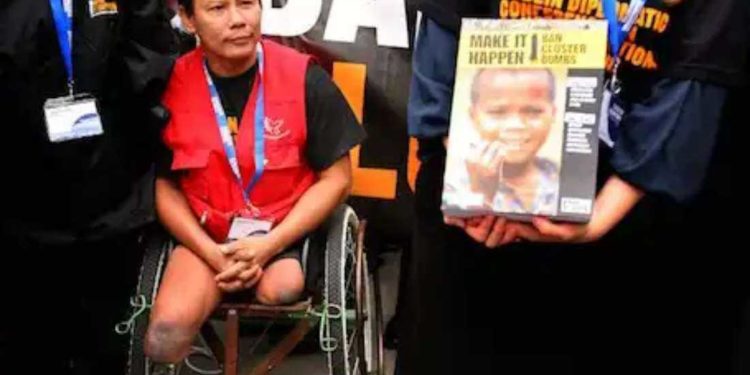The number of victims went up sharply year on year amid the human quest for more land
Tun Channareth, a Cambodian war remnant survivor, is pictured in this May 2008 file photo. Authorities say clearing mines has been going pretty well in Cambodia but has its issues, including access to closed-off, old military sectors near the Thai border. (Photo: AFP/UCA files)
A landmine-free Cambodia by 2025 remains ambitious but doable, authorities say, two years after launching a concerted effort to eradicate the scourge with the backing of Western countries and the United Nations Development Programme (UNDP).
“Over these last two years, mine clearing has been going pretty well,” said Heng Ratana, director-general of the Cambodian Mine Action Centre (CMAC). “Even in 2021, when we had the Covid-19 crisis, we still did a good job in clearing landmines.”
However, the project still has its issues, including access to closed-off, old military sectors near the Thai border. Demining is also complicated by difficult, sloping topography, especially in heavily forested areas where bamboo is common. And there is a $76 million funding shortfall.


“Other issues that we are now facing are about land use because people need more land and we have less land than people. That’s why some people are using land that still contains landmines and they get into danger,” Heng Ratana added.
That has been reflected in the statistics.
From 1979 to August 2022, landmine and explosive remnants of war (ERW) explosions claimed 19,818 lives and either injured or amputated 45,186 others. For the first six months of this year landmines and ERW claimed 40 victims, up 23 percent from the same period a year ago.
Of them 10 were killed, 23 injured and seven people maimed.
It’s the legacy of a 30-year war, which ended in 1998, that left between four million and six million landmines and other munitions across the country.
Under Article 5 of the Anti-Personnel Mine Ban Convention, Cambodia is required to destroy all known anti-personnel mines in areas under its jurisdiction or control as soon as possible — but not later than Dec. 31, 2025.
The current deadline followed an extension, granted in 2019, and Cambodia announced the following year it would bolster its demining force, adding an extra 2,000 deminers with the backing of the UNDP.
Alissar Chaker, Cambodia’s UNDP Resident Representative, said Cambodia had declared its first mine-free province in Kep on the south coast last February and since then four more provinces and the capital Phnom Penh have also declared landmine free.
But about one million people still lived in contaminated areas across Cambodia.
“A mine-free Cambodia by 2025 is ambitious but can be achieved by accelerating resource mobilization, strengthening monitoring and operational capacity and cooperation, and implementing robust quality assurance and information management practices,” she said.
According to UNDP estimates Cambodia needs $136 million to clear 716 square kilometers of contaminated land but the government is facing a $76 million shortfall.
“Mine action is a collective responsibility,” Chakar said, adding that compared to other countries and operators, clearance costs per square meter are significantly lower in Cambodia.
“However, this cost and the time to clear remaining areas will increase over time. The last leg is often the hardest as it comprises mostly dense or hard-to-access places,” she said.
On July 4, Prime Minister Hun Sen launched a fundraising drive targeting $90 million more to fill the gap, saying he wanted to create a “big national movement” that would rid the country of ERWs once and for all.
“We don’t want to have more handicapped people or deaths,” Hun Sen told athletes at the Asean Para Games in Indonesia. He also noted that Cambodia relied on funds from Australia, Japan, South Korea, Europe and the US for its demining efforts.
“I have an initiative to prepare a plan to push this situation forward. Donors have their targets but we cannot use their funds as per our own wishes,” he said.
The fund has so far raised more than $20 million and two weeks ago Australia, which has spent around $70 million on demining since 1994, was asked to continue supporting the work until the last landmines are destroyed “even if we do not achieve the mine-free goal by 2025.”
“We are doing quite well,” Heng Ratana said. “We cannot say exactly that we will finish our plan on time but we keep doing our best and there might be some unexpected issues that pop up, such as money or other issues.”
Sreynat Sarum contributed to this story.
Latest News
Credit: Source link




